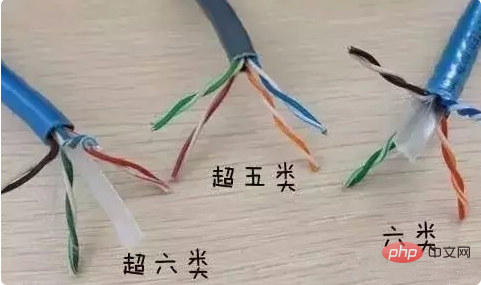How to distinguish between several types of network cables
Methods to distinguish several types of network cables: 1. The internal structures of Category 6 network cables and Category 5 network cables are different. The internal structure of Category 6 network cables adds a cross skeleton; 2. The copper core size of Category 6 network cables and Category 5 network cables Differently, the copper core of Category 5 network cable is [0.45mm] or less.

How to distinguish several types of network cables:
The distinction methods are as follows:
1. Six The internal structures of Category 6 network cables and Category 5 network cables are different. The internal structure of Category 6 network cables adds a cross skeleton. The four pairs of twisted pair cables are placed in the four grooves of the cross skeleton. The cross skeleton in the center of the cable changes with the length. The rotation angle changes;
2. The copper core size of Category 6 network cable and Category 5 network cable is different. The copper core of Category 5 network cable is less than 0.45mm, the copper core of Category 5e network cable is 0.45mm-0.51mm, and the copper core of Category 6 network cable is 0.45mm-0.51mm. The standard one is 0.56mm-0.58mm.
3. Category 5 network cable: The outer cover will be marked with "CAT5" and the transmission bandwidth is 100MHz. It is used for voice transmission and data transmission with a maximum transmission rate of 100Mbps. It is mainly used for 100M network and 10M network. Has been replaced by Category 5e cable.
4. Category 5e network cable: The outer layer is marked with "CAT5e" and the transmission bandwidth can be as high as 1000Mb/s. However, it is generally only used in 100Mb/s networks and only connects desktop switches to computers because Category 5e unshielded network cables require the support of expensive special equipment.
5. Category 6 network cable: The outer surface is marked with "CAT6", which generally refers to unshielded network cables. It is mainly used in Gigabit networks, and its transmission performance is much higher than the Category 5e network cable standard.

Extended information:
Types of network cables
Twisted pair cables can be divided into For unshielded twisted pair (UTP) and shielded twisted pair (STP).
The outer layer of shielded twisted pair cable is wrapped with aluminum platinum to reduce radiation, but it cannot completely eliminate radiation. The price of shielded twisted pair cable is relatively high, and it is more expensive to install than unshielded twisted pair cable. difficulty.
Unshielded twisted pair cable has the following advantages: unshielded jacket, small diameter, saving occupied space; light weight, easy to bend, easy to install; minimize or eliminate near-end crosstalk; with Flame retardant; independent and flexible, suitable for structured integrated wiring.
Common models of twisted pair cables are as follows:
Category 1 line (CAT1): mainly used to transmit voice (Class 1 standard was mainly used before the early 1980s telephone cable), unlike data transmission.
Category 2 line (CAT2): The transmission frequency is 1MHZ, used for voice transmission and data transmission with a maximum transmission rate of 4Mbps. It is common in old token networks that use the 4MBPS standard token passing protocol.
Category 3 cable (CAT3): Transmission frequency 16MHz, used for voice transmission and data transmission with a maximum transmission rate of 10Mbps. It is mainly used for 10BASE--T, a cable specified in the ANSI and EIA/TIA568 standards.
Category 4 line (CAT4): The transmission frequency is 20MHz, used for voice transmission and data transmission with a maximum transmission rate of 16Mbps. It is mainly used for token-based LAN and 10BASE-T/100BASE-T.
Category 5 line (CAT5): The transmission frequency is 100MHz, used for voice transmission and data transmission with a maximum transmission rate of 100Mbps. It is mainly used for 100BASE-T and 10BASE-T networks. This is the most commonly used Ethernet Network cable, this type of cable has increased winding density and is coated with a high-quality insulating material.
Category 5e (CAT5e): The transmission frequency is 100MHz, mainly used for Gigabit Ethernet (1000Mbps).
It has small attenuation, less crosstalk, higher attenuation to crosstalk ratio (ACR) and signal-to-noise ratio (Structural Return Loss), smaller delay difference, and greatly improved performance.
Category 6 cable (CAT6): The transmission frequency is 250MHz, most suitable for applications with transmission rates higher than 1Gbps, mainly used for Gigabit Ethernet (1000Mbps).
Category 6 twisted pair is somewhat different from Category 5 or Category 5e twisted pair in appearance and structure. It not only adds an insulated cross frame, but also separates the four pairs of twisted pairs. Placed within the four grooves of the cross frame, the diameter of the cable is also thicker.
Category 6e or 6A (CAT6A): The transmission frequency is 200~250 MHz, the maximum transmission speed can also reach 1000 Mbps, and it is mainly used in gigabit networks.
Category 6e cable is an improved version of Category 6 cable. It is also an unshielded twisted pair cable specified in ANSI/EIA/TIA-568B.2 and ISO Category 6/E-class standards. Crosstalk, attenuation and signal-to-noise ratio have been greatly improved.
Category 7 line (CAT7): The transmission frequency can reach at least 500 MHz and the transmission rate can reach 10 Gbps. It is mainly designed to adapt to the application and development of 10 Gigabit Ethernet technology. This line is the latest shielded twisted pair in the ISO Category 7/Class F standard.
The above is the detailed content of How to distinguish between several types of network cables. For more information, please follow other related articles on the PHP Chinese website!

Hot AI Tools

Undresser.AI Undress
AI-powered app for creating realistic nude photos

AI Clothes Remover
Online AI tool for removing clothes from photos.

Undress AI Tool
Undress images for free

Clothoff.io
AI clothes remover

Video Face Swap
Swap faces in any video effortlessly with our completely free AI face swap tool!

Hot Article

Hot Tools

Notepad++7.3.1
Easy-to-use and free code editor

SublimeText3 Chinese version
Chinese version, very easy to use

Zend Studio 13.0.1
Powerful PHP integrated development environment

Dreamweaver CS6
Visual web development tools

SublimeText3 Mac version
God-level code editing software (SublimeText3)

Hot Topics
 1386
1386
 52
52
 What network cable to use for 2.5g network port?
Mar 20, 2023 pm 02:09 PM
What network cable to use for 2.5g network port?
Mar 20, 2023 pm 02:09 PM
The 2.5g network port uses Category 5e network cables and can be connected to Gigabit network cables. The 2.5G port is a network interface with a rate of 2.5Gbps. The actual rate is usually calculated as 2500Mbps; and the Category 5e network cable (cat 5e) can fully meet the transmission requirements of 2.5Gbps and 1000Mbps. Category 5e unshielded twisted pair is a cable that has improved some of the performance of Category 5 shielded twisted pair. Many performance parameters, such as near-end crosstalk, attenuation to crosstalk ratio, return loss, etc., have been improved. But its transmission bandwidth is still 100MHz.
 Is the Category 6e cable marked 6e or 6a?
Oct 28, 2022 pm 02:06 PM
Is the Category 6e cable marked 6e or 6a?
Oct 28, 2022 pm 02:06 PM
The logo of Category 6e network cable is 6a, and its complete logo is CAT6A; CAT6E is an improved version of CAT6, but not CAT6A; Category 6e network cable and Category 6 network cable generally have a cross skeleton with insulating effect added to the internal structure, and will Arrange 4 pairs of twisted pairs in the 4 grooves of the cross frame respectively. However, the cross frame inside the Category 6e network cable generally uses a gear-shaped cable trough shape, while the cross frame of the Category 6 network cable is generally a straight line. Isolated.
 What types of network cables are hsyv-6?
Jul 12, 2022 pm 02:03 PM
What types of network cables are hsyv-6?
Jul 12, 2022 pm 02:03 PM
"hsyv-6" is Category 6 twisted pair (network cable); hsyv means twisted pair, and "6" means CAT6, which is Category 6. Category 6 network cable supports up to Gigabit network, which is 100M Category 5 An upgraded version of the network cable, the Category 6 twisted pair is somewhat different from the Category 5 or Category 5e twisted pair in appearance and structure. It not only adds an insulated cross frame, but also separates the four pairs of twisted pairs. in the four grooves of the cross frame, and the diameter of the cable is also thicker.
 What types of network cables are hsyv-5e?
Mar 06, 2023 pm 03:10 PM
What types of network cables are hsyv-5e?
Mar 06, 2023 pm 03:10 PM
hsyv-5e is a Category 5e network cable; hsyv represents the structure of the line, and 5e represents Category 5e. Its transmission frequency is as high as 100MHz. It is a Gigabit network cable and can be used in Gigabit networks, and the hsyv-5e center line The twist of the pair is denser, the signal transmission is faster, the quality is better, and the durability is better.
 What should I do if the network cable is plugged in but the network cannot be recognized?
Jul 05, 2023 pm 03:47 PM
What should I do if the network cable is plugged in but the network cannot be recognized?
Jul 05, 2023 pm 03:47 PM
There are three solutions to the problem that the network cable is plugged in but the network cannot be recognized: 1. Unplug the network cable and restart the router; 2. Press Win+X, select Settings, click Network and Internet, select Ethernet and click Change Adapter Options, click After selecting Disable Local Connection, click again to select Enable; 3. Click Status in the Network and Internet interface, then select Network Reset in the pop-up interface, click Reset Now, and then the computer will restart within 5 minutes to complete the reset.
 What kind of network cable is hsyu5e?
Oct 21, 2022 am 09:31 AM
What kind of network cable is hsyu5e?
Oct 21, 2022 am 09:31 AM
hsyu5e is a Category 5e twisted pair, which has the characteristics of small attenuation and less crosstalk, and has higher attenuation to crosstalk ratio (ACR) and signal to noise ratio (signal to noise ratio), smaller delay difference, high performance greatly improved. The transmission frequency of hsyu5e is as high as 100MHz. It is a Gigabit network cable and can be used in Gigabit networks. The twisting degree of the wire pairs in hsyv5e is relatively dense, so the signal transmission is fast, the quality is better, and the durability is better.
 4pairs are several types of network cables
Nov 22, 2022 am 11:52 AM
4pairs are several types of network cables
Nov 22, 2022 am 11:52 AM
4pairs is Category 5 network cable. Category 5 cable is a twisted pair cable used in computer networks. It is also a multimedia cable used for data, voice and other information communication services. It is widely used in Ethernet and broadband access projects. Its quality is directly related to to the transmission quality of information communications.
 What is the line sequence of Class B network cables?
Mar 03, 2023 am 11:01 AM
What is the line sequence of Class B network cables?
Mar 03, 2023 am 11:01 AM
The line sequence of class b network cable refers to the line sequence of class b network cable. According to the standard wiring of T568B, 12345678 is orange and white, orange, green and white, blue, blue and white, green, brown and white, and brown. Both ends of the network cable follow this Prepare the crystal head in line sequence.



